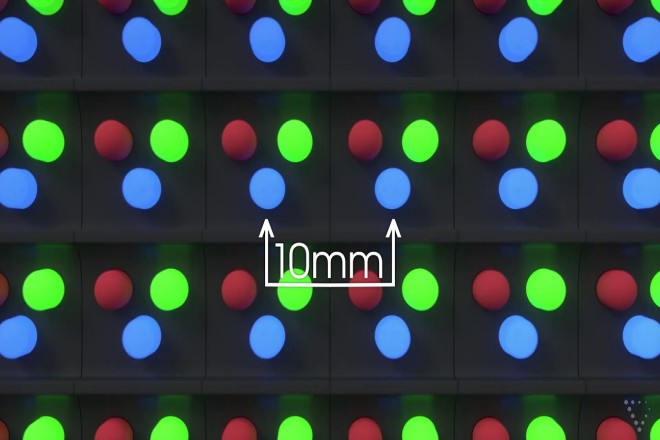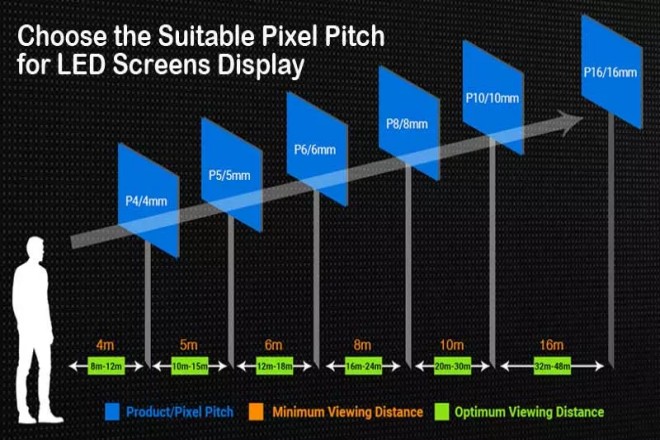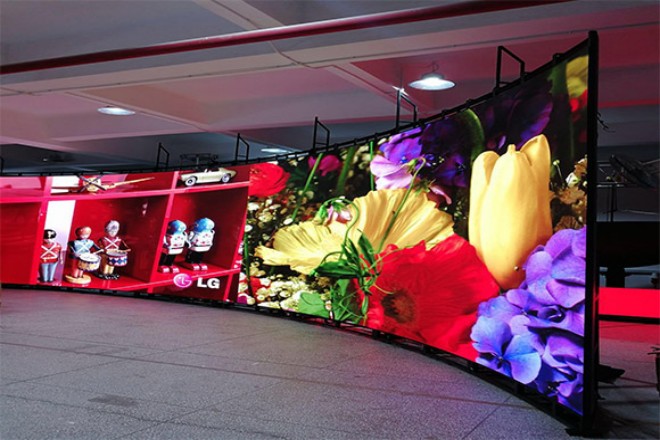Introducción

En la era digital, pantallas LED al aire libre Se han convertido en un medio indispensable en el paisaje urbano, la publicidad comercial, la comunicación cultural y otros campos con sus ventajas de alto brillo, alta definición, colores brillantes y fuertes efectos dinámicos.
Con el avance continuo de la tecnología y la creciente riqueza de escenarios de aplicación, es particularmente importante elegir una pantalla LED para exteriores adecuada.
Como indicador clave para medir la claridad y resolución de la pantalla, la elección de tamaño de píxel Afecta directamente el efecto de visualización, la experiencia de visualización y el retorno de la inversión.
Por lo tanto, este artículo tiene como objetivo explorar en profundidad cómo elegir de manera científica y razonable el paso de píxeles al comprar una pantalla LED para exteriores con el fin de proporcionar una referencia y orientación valiosas para los tomadores de decisiones relevantes.
1. Comprenda qué es el paso de píxeles de la pantalla LED
Imagínate que estás frente a una enorme pantalla LED, que está compuesta por innumerables pequeñas luces LED, cada una de las cuales puede emitir luz de diferentes colores.
Estas luces LED son píxeles que se disponen juntos para formar las imágenes y los vídeos que vemos. El pixel pitch es la distancia física entre estas luces LED (o píxeles), que se expresa en milímetros (mm). Por ejemplo, P3 significa que la distancia entre dos píxeles adyacentes es de 3 mm.
2. Tenga en cuenta la distancia de visualización de la pantalla LED

Cuando consideramos la distancia de visualización En el caso de la pantalla LED, la elección del paso de píxeles adecuado es muy importante. La distancia de visualización y el paso de píxeles
1) Relación entre el tono
Imagina que estás frente a una enorme pantalla LED. Esta pantalla está formada por muchas luces pequeñas (las llamamos píxeles) que se encienden juntas para mostrar imágenes o vídeos.
2) Observación detallada:
Si te sitúas muy cerca, como si estuvieras viendo una película en la primera fila de un cine, querrás ver una imagen muy clara y delicada.
En este momento, es necesario elegir una pantalla con un tamaño de píxeles más pequeño. Debido a que los píxeles son más densos, los espacios entre ellos son más pequeños y la imagen se ve más suave y delicada.
3) Visualización a larga distancia:
Sin embargo, si estás lejos, por ejemplo en una plaza mirando un cartel publicitario a lo lejos, entonces no necesitas tanta claridad.
Debido a que desde la distancia, los píxeles pequeños se mezclan y no se puede notar la diferencia entre ellos, en este momento se puede elegir una pantalla con una distancia entre píxeles ligeramente mayor, que puede satisfacer las necesidades de visualización y ahorrar costos.
4) ¿Cómo elegir el tamaño de píxel?
Para ayudarle a hacer una mejor elección, le presentamos un método de referencia simple (pero tenga en cuenta que se trata solo de una estimación aproximada):
Para aplicaciones al aire libre, puedes intentar hacer una estimación con una fórmula sencilla. La fórmula es: “La distancia entre píxeles (mm) es aproximadamente igual a la distancia de visualización (metros) dividida por 750”.
Por ejemplo, si la distancia de visualización es de 10 metros, entonces se puede estimar que el tamaño de píxel es aproximadamente 10 dividido por 750, que es 0,013 mm.
Pero recuerda que, de hecho, el tamaño de píxel se mide en milímetros enteros, por lo que debes elegir el valor estándar más cercano, como P4 (es decir, 4 mm).
Puntos a tener en cuenta
No se limite a mirar los números: aunque las fórmulas y las estimaciones son útiles, lo más importante es tener en cuenta sus necesidades específicas. Por ejemplo, si está eligiendo una pantalla para un gran evento, es posible que necesite un mayor brillo y un tamaño mayor, no solo una menor distancia entre píxeles.
Consideraciones de costo: Las pantallas con una distancia entre píxeles menor suelen ser más caras. Por lo tanto, considere su presupuesto al elegir y encontrar la opción más rentable.
Comodidad visual: Por último, no olvides tener en cuenta la comodidad visual de la audiencia. Una distancia entre píxeles demasiado pequeña puede provocar fatiga ocular a corta distancia, mientras que una distancia entre píxeles demasiado grande puede hacer que la imagen se vea borrosa a larga distancia.
3. Considere los escenarios de aplicación de la pantalla LED.

1) Escenario de demanda de HD
Imagínate que estás viendo una película en HD o caminando por una calle comercial concurrida y ves una valla publicitaria digital.
- Reproducción de vídeo HD:
Cuando te sientas en una sala de cine o frente a un televisor HD en casa para ver una película, quieres que la imagen sea muy clara, colorida y rica en detalles.
De manera similar, si ves una cartelera digital que reproduce videos en HD en un centro comercial o exposición, también quieres que tenga un efecto visual parecido al del cine.
Por lo tanto, para aquellos escenarios que requieren mostrar contenido HD, deberíamos elegir pantallas LED con pasos de píxeles más pequeños, como P2.5 o P3.
Estas pantallas pueden proporcionar una resolución más alta, haciendo que la imagen sea más delicada y los colores más saturados, haciendo que el público se sienta como si estuviera en la imagen.
- Vallas publicitarias digitales:
Las vallas publicitarias digitales suelen ubicarse en lugares con mucho tráfico, como calles comerciales, centros comerciales, etc.
Para atraer la atención de los peatones y transmitir información publicitaria eficaz, el contenido de la valla publicitaria debe ser muy claro y llamativo.
Por lo tanto, para escenarios de demanda de alta definición como vallas publicitarias digitales, también necesitamos elegir pantallas LED con distancias entre píxeles más pequeñas.
2) Escenarios de visualización a larga distancia
Ahora, imaginemos que estás viendo una gran valla publicitaria al aire libre o viendo un partido deportivo.
Cuando conduces por la autopista o ves un enorme cartel publicitario en un rascacielos de la ciudad, normalmente lo ves desde una gran distancia. Debido a la gran distancia, tu visión no puede distinguir detalles muy pequeños, por lo que no se necesita una resolución demasiado alta.
Por el contrario, para reducir los costes y adaptarse a los entornos exteriores, podemos optar por pantallas LED con un tamaño de píxeles ligeramente mayor, como P6 o P8. Estas pantallas pueden mantener buenos efectos visuales cuando se ven a larga distancia y tienen una alta relación coste-beneficio.
En los estadios, los espectadores suelen sentarse lejos de la pantalla para ver partidos o actuaciones. Por ello, para escenarios de visualización a larga distancia como los estadios, también podemos optar por pantallas LED con pixel pitch ligeramente mayor.
Esto no sólo reduce costes, sino que también garantiza que el público pueda ver claramente el contenido en la pantalla desde larga distancia.
3) Escenarios especiales de demanda
A continuación, consideremos algunos escenarios con necesidades especiales, como las señales de tráfico y el monitoreo a larga distancia.
- Señales de tráfico:
Las señales de tráfico suelen estar situadas al costado o sobre la carretera para indicar la dirección y las precauciones que debe tomar el conductor. Dado que los conductores necesitan obtener información de forma rápida y precisa mientras conducen, las señales de tráfico deben ser muy claras y legibles.
Para estos escenarios de demanda especiales, podemos elegir un tamaño de píxel moderado, como P4 o P5. Este tipo de pantalla no solo puede garantizar la claridad de las señales de tráfico, sino que además no aumentará los costes ni las dificultades de mantenimiento debido a una densidad de píxeles excesiva.
- Monitoreo a larga distancia:
En escenarios de monitoreo a larga distancia, necesitamos capturar objetivos distantes y mostrar sus detalles. Para garantizar la claridad y el rendimiento de detalle de la pantalla de monitoreo, podemos elegir un tamaño de píxel moderado. Esto no solo puede satisfacer las necesidades de monitoreo, sino que también garantiza la calidad y la estabilidad de la pantalla de monitoreo.
4. Considere los factores de costo de las pantallas LED

1) Coste de fabricación: la relación entre el tamaño de los píxeles y el dinero
Imagina que si quieres un lienzo súper delicado para pintar, entonces la cuadrícula de este lienzo (como los píxeles de la pantalla LED) debe ser muy pequeña, ¿verdad? Sin embargo, hacer un lienzo con una cuadrícula tan pequeña es mucho más difícil y costoso que hacer un lienzo con una cuadrícula grande.
Porque se necesitan más materiales y una artesanía más delicada, y es posible que se necesiten herramientas más avanzadas.
De manera similar, en el caso de las pantallas LED, cuanto menor sea la distancia entre píxeles, más microesferas LED habrá en la pantalla y cada una de ellas deberá colocarse y conectarse con precisión, lo que naturalmente requiere más tiempo y dinero. Por lo tanto, las pantallas LED con distancias entre píxeles pequeñas costarán más de fabricar.
2) Inversión a largo plazo: mirar a largo plazo
Ahora, supongamos que compras un cuadro con muchos detalles para decorar tu casa u oficina. Aunque el cuadro cuesta mucho dinero al principio, cada vez que alguien lo vea, se sentirá atraído por su belleza y elogiará tu gusto. De esta manera, tu casa u oficina se vuelve más atractiva y puede traerte más oportunidades o amigos.
Lo mismo ocurre con las pantallas LED. Aunque la inversión inicial en una pantalla con una distancia entre píxeles pequeña puede ser mayor, puede proporcionar una imagen más clara y detallada.
Esto significa que sus anuncios, vídeos o información pueden transmitirse mejor a la audiencia, atrayendo su atención y mejorando su imagen de marca o los resultados de su negocio. A largo plazo, es probable que dicha inversión traiga más beneficios y retornos.
3) Rentabilidad: encontrar un punto de equilibrio
Entonces, ¿cómo elegimos? ¿Tenemos que comprar la pantalla más cara con la menor distancia entre píxeles? No necesariamente. Al igual que cuando compramos ropa, no tenemos que elegir siempre la más cara, sino la que mejor se adapte a nosotros y tenga la mejor relación calidad-precio.
En el caso de las pantallas LED, debemos encontrar un punto de equilibrio en función de nuestras necesidades y nuestro presupuesto. Si el escenario de aplicación no requiere una resolución alta o si su presupuesto es limitado, puede ser más adecuado elegir una distancia entre píxeles ligeramente mayor. Esto puede satisfacer las necesidades y ahorrar costos.
Conclusión
En resumen, elegir la distancia entre píxeles adecuada para las pantallas LED para exteriores es un proceso de consideración integral, que requiere tener en cuenta totalmente la distancia de visualización, los escenarios de aplicación, los factores de costo y otros indicadores técnicos de la pantalla.
La selección científica y racional del paso de píxeles no solo puede garantizar que la claridad y la resolución de la pantalla satisfagan las necesidades reales, sino que también controla eficazmente los costos de inversión al tiempo que garantiza la experiencia de visualización y logra la mejor relación costo-beneficio.
Espero que la discusión en este artículo pueda brindarle alguna inspiración útil y ayuda para que las pantallas LED para exteriores puedan desarrollar su valor y encanto únicos en más campos.
Finalmente, si quieres saber más sobre las pantallas LED, Por favor póngase en contacto con nosotros.
